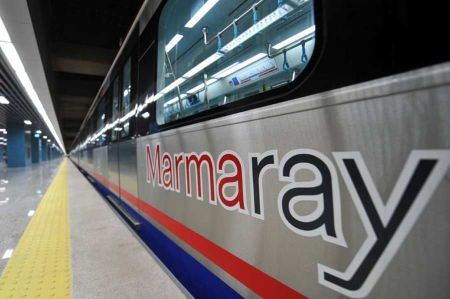Istanbul - Marmaray Railway Tunnel opened
- Written by Portal Editor
The dream began during the Ottoman Empire in 1860: Asia and Europe were to be connected under the Bosphorus with the help of a tunnel.
At that time, the so-called Baghdad Railway and the Anatolian Railway helped Turkey, which had a weak infrastructure, to gain economic momentum in order to find a connection to Europe. Even the well-to-do passengers of the legendary Orient Express had to take the ferry from the European to the Asian part of Istanbul if they wanted to continue their journey towards Baghdad.
At that time, the engineers were thinking about a kind of tube system
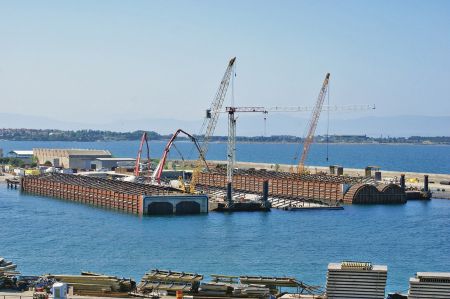 The first concrete plans for a tunnel under the straits existed as early as 1891. At that time, Abdülmecid II commissioned French, British and American engineers with studies. But the caliph capitulated in the face of the technical challenges and the immense costs of the project. The Ottoman Empire relied on engineers from Germany for the technical knowledge and execution of the railway projects when it came to railway construction. Some railway lines have been preserved to this day, so the German influence can be seen particularly in the railway stations and bridges in Central Anatolia. Despite extensive knowledge of tunnel construction, it was not possible for the technicians of the time to put the Bosphorus tunnel project into practice. At that time, the engineers were thinking about a kind of tube system that would run on pillars deep down in the water but above the seabed.
The first concrete plans for a tunnel under the straits existed as early as 1891. At that time, Abdülmecid II commissioned French, British and American engineers with studies. But the caliph capitulated in the face of the technical challenges and the immense costs of the project. The Ottoman Empire relied on engineers from Germany for the technical knowledge and execution of the railway projects when it came to railway construction. Some railway lines have been preserved to this day, so the German influence can be seen particularly in the railway stations and bridges in Central Anatolia. Despite extensive knowledge of tunnel construction, it was not possible for the technicians of the time to put the Bosphorus tunnel project into practice. At that time, the engineers were thinking about a kind of tube system that would run on pillars deep down in the water but above the seabed.
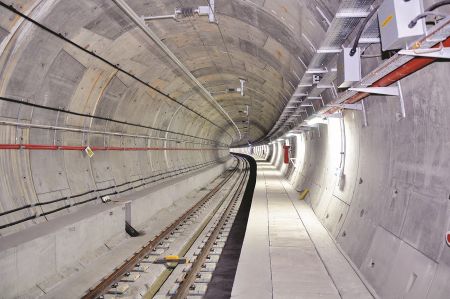 On the 90th anniversary of the founding of the Republic of Turkey, this long-cherished dream could finally be fulfilled: the tunnel of the "Marmaray railway line" was officially opened. Now the Marmaray Railway, which will later have a total length of 76 kilometres, connects both parts of Istanbul, which are only a few minutes apart due to the tunnel. Much to the delight of the stressed-out commuters in the 17 million metropolis of Istanbul. The subway and the now open tunnel under the Sea of Marmara are intended to relieve the chronically congested streets of Istanbul, on which around three million cars travel every day. The two existing highway bridges over the Bosphorus are crossed by 140 million vehicles a year - almost three times the originally planned capacity. A third bridge, currently under construction and due for completion in 2015, will only be able to accommodate part of this traffic. A cable car between Asia and Europe is also planned by 2015. While the journey on one of the Bosphorus ferries previously took at least 20 minutes, in future you can get from one bank to the other in four minutes.
On the 90th anniversary of the founding of the Republic of Turkey, this long-cherished dream could finally be fulfilled: the tunnel of the "Marmaray railway line" was officially opened. Now the Marmaray Railway, which will later have a total length of 76 kilometres, connects both parts of Istanbul, which are only a few minutes apart due to the tunnel. Much to the delight of the stressed-out commuters in the 17 million metropolis of Istanbul. The subway and the now open tunnel under the Sea of Marmara are intended to relieve the chronically congested streets of Istanbul, on which around three million cars travel every day. The two existing highway bridges over the Bosphorus are crossed by 140 million vehicles a year - almost three times the originally planned capacity. A third bridge, currently under construction and due for completion in 2015, will only be able to accommodate part of this traffic. A cable car between Asia and Europe is also planned by 2015. While the journey on one of the Bosphorus ferries previously took at least 20 minutes, in future you can get from one bank to the other in four minutes.
Concrete double tube under the Sea of Marmara
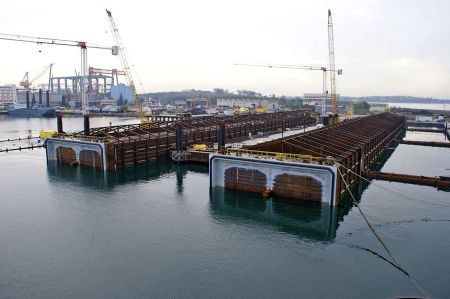 The core of the new city connection was opened: the approximately 13.6-kilometer-long tunnel between the European and Asian parts of Istanbul, including a 1.4-kilometer-long and earthquake-proof double tube made of concrete under the Sea of Marmara on Republic Day. The technical challenges of the project that started in 2004 were enormous. Large tunnel boring machines have drilled their way from both sides to the bottom of the strait down to a depth of around 50 metres. Eleven tunnel elements made of concrete and steel were anchored on the ground at a depth of 56 meters. The 9.8-kilometer long tunnel now runs partly underground and partly as a tube washed into the sea floor.
The core of the new city connection was opened: the approximately 13.6-kilometer-long tunnel between the European and Asian parts of Istanbul, including a 1.4-kilometer-long and earthquake-proof double tube made of concrete under the Sea of Marmara on Republic Day. The technical challenges of the project that started in 2004 were enormous. Large tunnel boring machines have drilled their way from both sides to the bottom of the strait down to a depth of around 50 metres. Eleven tunnel elements made of concrete and steel were anchored on the ground at a depth of 56 meters. The 9.8-kilometer long tunnel now runs partly underground and partly as a tube washed into the sea floor.
In the coming years, the "Marmaray" route in Europe and Asia is to be expanded by more than 60 kilometres of ground-level tracks. Then, according to the planning, the journey between the final stops Gebze on the Asian side in the southeast of Istanbul to Halkali in the European west of the city will take about one hour and 45 minutes - about half the time that is currently expected. “Marmaray” is to be integrated into Istanbul's metro network, which is also being expanded. By 2030, the city wants to have almost 800 kilometres of local transport rails; currently it is 124 kilometres. The trains, which run every two minutes, are intended to transport up to 75,000 people per hour. The "Marmaray" project, which costs almost five billion dollars, is also intended to give new impetus to international travel and freight traffic.
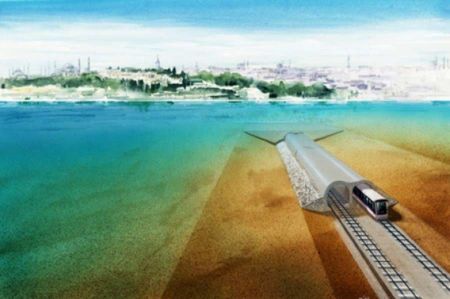 The designers promise that the tunnel will withstand even the most severe earthquakes - the North Anatolian Fault Zone is only 20 kilometres away. As a result, some earthquake experts have unfounded concerns about the safety of the underground facilities. Transport Minister Binali Yildrim promises in advance that the tunnel is the safest structure in Istanbul. Prime Minister Recep Tayyip Erdogan himself drove a train through the tunnel during a test run in August. "Our ancestors worked on the drafts. But the realization is now ours," he says.
The designers promise that the tunnel will withstand even the most severe earthquakes - the North Anatolian Fault Zone is only 20 kilometres away. As a result, some earthquake experts have unfounded concerns about the safety of the underground facilities. Transport Minister Binali Yildrim promises in advance that the tunnel is the safest structure in Istanbul. Prime Minister Recep Tayyip Erdogan himself drove a train through the tunnel during a test run in August. "Our ancestors worked on the drafts. But the realization is now ours," he says.
President Abdullah Gül, Prime Minister Tayyip Erdogan and almost the entire cabinet have travelled to the ceremonial opening of the tunnel on the 90th anniversary of the founding of the Turkish Republic. Japan's Prime Minister Shinzo Abe travelled from Tokyo - the tunnel was built by a Turkish-Japanese consortium of companies. On October 29, the head of state ceremoniously opened the railway tunnel under the Sea of Marmara in Istanbul.
"We connect London and Beijing," Prime Minister Recep Tayyip Erdogan recently enthused. The rail connection, which took nine years to build and was partially supported by the European Investment Bank (EIB), is intended to make changing trains superfluous. "It's a 150-year-old dream," said Erdogan, who inaugurated "Marmaray" along with President Abdullah Gul on the 90th anniversary of the founding of the Turkish Republic.
Some tunnel builders and Turkish government officials say they have connected Asia and Europe for the first time. However, that is wrong: you can already travel by train from London to Beijing via Berlin and Moscow. In the Urals, the Trans-Siberian Railway crosses the border between Europe and Asia. “Marmaray” is therefore a possible alternative route.
But Turkey is already thinking ahead. In a second step, the railway tunnel will also be expanded for long-distance traffic. "With the Marmaray project, Beijing and London are connected with a rail corridor," said Süleyman Karaman, head of the Turkish state railway company TCDD. The route is also intended to be part of an "iron Silk Road" between Asia, the Middle East and Europe.
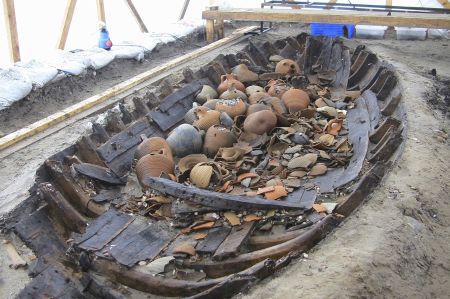 Work had been delayed for years because a complete Byzantine port was found during the construction of an underground train station near Istanbul's old city on the European shore - archaeologists worked around the clock at times to secure the rich finds, including more than 30 ships.
Work had been delayed for years because a complete Byzantine port was found during the construction of an underground train station near Istanbul's old city on the European shore - archaeologists worked around the clock at times to secure the rich finds, including more than 30 ships.
Scientists also criticize that the works on the tunnel under the seabed have caused serious damage to the marine life of the Marmara Sea. The large-scale projects pushed through by Erdogan in an authoritarian manner are always highly controversial. Citizens are protesting not only because valuable forest, which was considered to be the city of Istanbul's water reservoir, is being cut down for the construction of the third Bosphorus bridge. Another major airport is planned on the European side, with which Istanbul intends to become one of the most important hubs in global air traffic. Erdogan also wants to connect the Black Sea and the Sea of Marmara with a canal. A kind of second Bosphorus is to be dug west of Istanbul for shipping traffic. The construction, which Erdogan proudly describes as a "crazy project," is scheduled to be completed by the Turkish Republic's 100th birthday in 2023.
Please read as well:
Harzer hiking needles - one system prevails!
Roman settlement Yverdon - alluvial soil of Lake Neuchâtel
